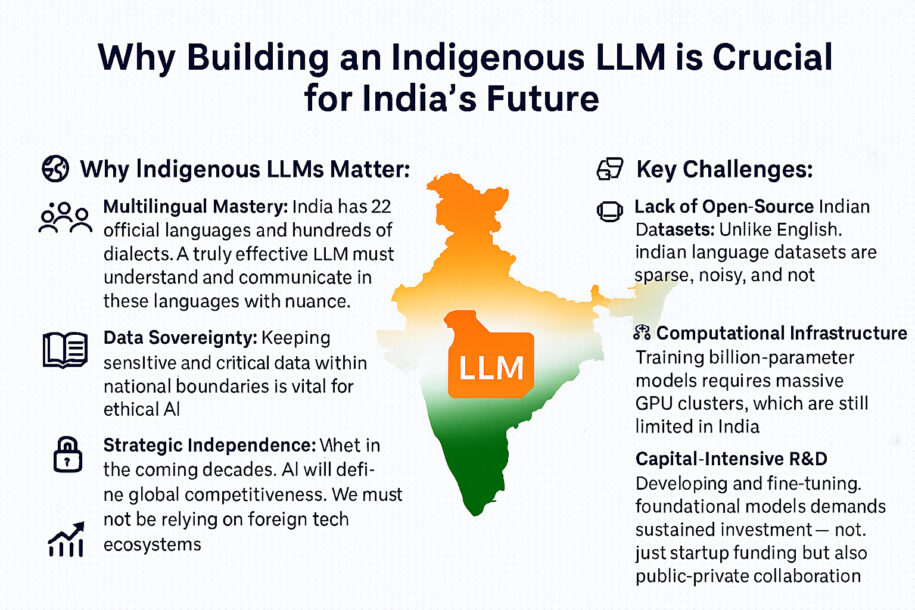Artificial Intelligence is rapidly transforming the global landscape — from healthcare and education to defense and governance. At the heart of this revolution are Large Language Models (LLMs) — powerful AI systems capable of understanding, processing, and generating human language at scale.
While the world is witnessing a surge of LLMs developed by global tech giants, the need for indigenous models tailored to India’s unique linguistic, cultural, and geopolitical context has never been more urgent.
In this article, we explore the significance of developing India’s own LLMs, the key challenges in doing so, and how early pioneers are paving the way for this vital mission.
🇮🇳 Why Indigenous LLMs Matter
🗣️ 1. Multilingual Mastery
India is home to 22 official languages and hundreds of dialects, each with its own script, syntax, and semantics. A global LLM trained primarily on English or Western data fails to capture the richness and nuances of Indian languages.
An indigenous LLM, trained on locally sourced, multilingual datasets, is essential for truly inclusive and equitable AI access.
📖 2. Cultural Relevance
AI is not just about language — it’s also about context and culture. A model trained on Indian idioms, festivals, mythologies, and market behavior can deliver far more meaningful and accurate responses to Indian users than a generic global model.
It’s about ensuring that technology understands us, not the other way around.
🔐 3. Data Sovereignty
With the growing focus on data privacy and national security, it is critical that sensitive user data is processed and retained within Indian boundaries. Relying on foreign LLMs often means submitting sensitive information to external systems, which can raise ethical and legal concerns.
📈 4. Strategic Independence
In the decades to come, AI will define economic and geopolitical power. Just as nations invest in defense, energy, and infrastructure, building AI capability is a strategic imperative.
We must not be dependent on foreign tech ecosystems for core AI infrastructure — we must build our own.
⚙️ Key Challenges in Developing Indigenous LLMs
Despite the vision and necessity, creating an indigenous LLM is not without its hurdles. Some of the most pressing challenges include:
📉 1. Lack of Open-Source Indian Datasets
Unlike English, Indian language datasets are sparse, noisy, and often not publicly available. Building large, diverse, and high-quality language corpora is one of the most critical foundational steps.
🧠 2. Computational Infrastructure
Training LLMs requires massive compute resources — high-end GPU clusters, parallel processing frameworks, and energy-efficient infrastructure. These are still limited and expensive in India.
💸 3. Capital-Intensive R&D
Developing and fine-tuning foundational models is a long-term investment. It requires sustained funding not just for model training, but also for continuous innovation, evaluation, and deployment.
This is where public-private partnerships and government incentives will play a major role in de-risking innovation.
🌟 A New Chapter Begins
India is at a pivotal moment. With its unmatched linguistic diversity, talent pool, and digital scale, it can lead the next wave of responsible, inclusive, and powerful AI systems.
Early pioneers have already started this journey, proving that it’s possible to dream big — and build even bigger.
This isn’t just a technological race. It’s about owning our future, telling our stories, and building tools that speak our languages.
Let’s support the indigenous AI movement — for a more inclusive, secure, and sovereign digital India. 🇮🇳
✨ Stay Connected
If you’re a developer, linguist, researcher, or investor interested in contributing to the mission of India-first AI, let’s connect and collaborate. The future is waiting to be built — and we have the voice to lead it.
#AI #LLM #MadeInIndia #DigitalIndia #ArtificialIntelligence #IndianLanguages #DataSovereignty #IndigenousTechnology #BharatGPT #StartupIndia #OpenSourceAI

